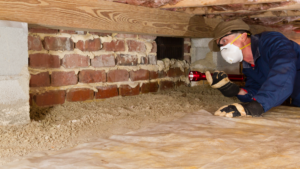
Termites pose a silent yet serious threat to homes all year round, including during the colder months. While many pests slow down in winter, termites remain active, often hidden from view. This makes it easy to overlook their presence and the damage they cause. Failing to detect termites early can lead to extensive and costly repairs.
Winter months can lull homeowners into a false sense of security, believing that termites are not a problem in cold weather. However, termites seek warmth and shelter, making the inside of your home an ideal place for them to thrive. Understanding how to uncover hidden termite damage during the colder months is crucial for maintaining the structural integrity of your home.
In this guide, we will explore why termite damage is often overlooked in winter, the signs of hidden damage, and effective techniques for detecting and preventing infestations. Taking these steps will help ensure your home remains safe and sound throughout the year.
Why Termite Damage is Commonly Overlooked in Colder Months
During colder months, many homeowners mistakenly believe that termites are not active. However, termites seek out warm environments, which often leads them to the interiors of homes. This misconception results in less vigilance and fewer inspections for termite damage during winter.
Termites are experts at staying hidden. They build their colonies deep inside walls, floors, and other structures where it’s warm. Because they tend to stay out of sight, it is easy to overlook them, especially when people expect most pests to hibernate or be inactive in the cold. Their ability to remain unnoticed allows them to cause extensive damage before being detected.
Another reason termite damage goes unnoticed in colder months is less outdoor activity. People spend more time indoors, focusing on keeping warm rather than inspecting their homes for pests. As a result, damage can accumulate long before the first signs appear. Understanding that termites remain active year-round can help homeowners stay alert and proactive in inspecting their properties.
Signs of Hidden Termite Damage to Look For
It’s important to recognize the signs of termite activity, even when they are not easily visible. Here are some clues that termites might be wreaking havoc in your home:
- Hollow Sounding Wood: Tap on wood surfaces around your home. If the wood sounds hollow, it could be a sign that termites have been eating away at it from the inside.
- Frass (Termite Droppings): Look for small, pellet-like droppings near wooden structures. These are termite droppings, also known as frass, and are a sure sign of an infestation.
- Mud Tubes: Check the foundation of your home, both inside and outside. Termites build mud tubes to travel between their nest and food sources. These tubes protect them from exposure to light and air.
- Bubbling or Peeling Paint: Termites can cause damage that affects the appearance of your home’s paint. If you notice paint that seems to bubble or peel, it might be due to termites consuming the wood underneath.
- Swollen Floors and Ceilings: As termites eat through wood, they can cause structural changes that lead to swelling or sagging in floors and ceilings.
Effective Techniques for Detecting Termite Infestations
Detecting termite infestations early can save you from extensive damage and costly repairs. Here are some effective techniques for identifying termite activity in your home:
- Professional Inspections: Hire a professional pest control service to perform a thorough inspection of your home. Experts have the tools and experience to detect termites in hard-to-reach areas.
- Moisture Meters: Termites are attracted to moisture. Using a moisture meter can help identify areas with high moisture levels that might attract termites. These areas often include basements, bathrooms, and kitchens.
- Sound Detection: Professional termite inspectors use special equipment to listen for termite activity inside walls. You can also tap on wood surfaces; if you hear a hollow sound, it could indicate termites.
- Thermal Imaging Cameras: Some pest control professionals use thermal imaging to detect temperature differences in your walls that might indicate termite activity. This method can uncover hidden colonies without invasive procedures.
- DIY Monitoring: Place termite bait stations around your home. While not as reliable as professional methods, they can serve as an early warning system.
Preventive Measures to Protect Your Home from Termites
Prevention is crucial when it comes to termites. Here are some effective measures to protect your home:
- Maintain Dry Conditions: Termites thrive in moist environments. Ensure your home has proper drainage, fix leaky pipes, and keep gutters clean. Use dehumidifiers in basements and other damp areas.
- Seal Entry Points: Check your home for cracks or gaps where termites could enter. Seal these openings with caulking or other appropriate materials.
- Remove Wood and Debris: Keep firewood and wood debris away from your home’s foundation. Termites can use these as a bridge to your house. Dispose of old tree stumps and other cellulose-based materials from your yard.
- Use Termite-Resistant Materials: When building or renovating, use termite-resistant materials like treated wood, metal, or concrete. These materials can help protect your home from termite invasions.
- Regular Inspections: Schedule annual termite inspections with a professional pest control service. Regular check-ups can catch infestations early and provide specific recommendations for your home.
Conclusion
Termites remain a hidden threat, especially during colder months when their activity can go unnoticed. Understanding why termite damage is often overlooked and recognizing the signs of hidden infestations are critical steps in protecting your home. You can minimize the risk of extensive damage by employing effective detection techniques and implementing preventive measures.
Every homeowner should take proactive steps, such as regular inspections, moisture control, and using termite-resistant materials. These strategies not only help in early detection but also play a significant role in preventing termite invasions in the first place.
Trust TDI for expert advice and professional termite inspections. Protect your home from hidden termite damage today by reaching out to us for a comprehensive solution tailored to your needs.
